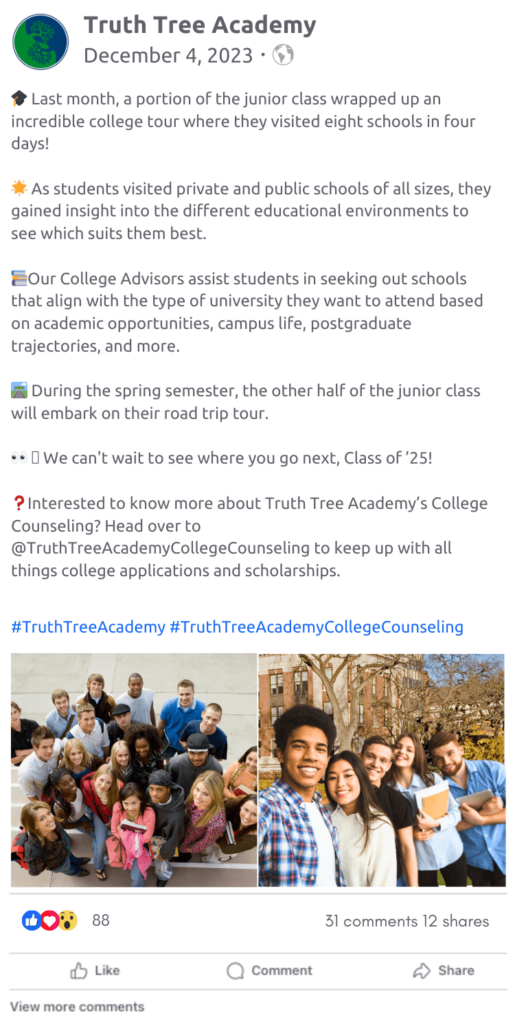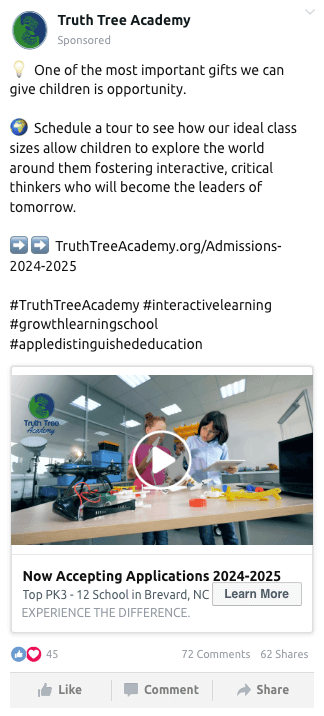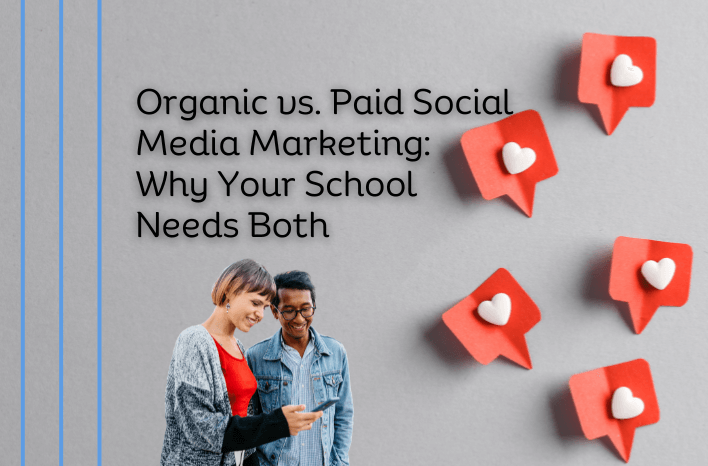By Maggie Twaroski, Truth Tree Contributor
Now that social media marketing has become routine in nearly every industry, we’re beginning to see how influential a strong social media presence can be in schools’ enrollment and retention efforts. Since a growing number of your school’s prospects are active on social media, you can use your platforms to attract a larger audience with more detailed insights into their interests, pain points, and priorities. In turn, you can increase your brand awareness and build trust in your school which will not only convert new families but also help retain current ones.
Still, while the potential for impactful social media marketing is high, many schools are only using it for occasional news updates, rather than part of a holistic strategy. The truth is, there’s a lot more you can do to interact with current and prospective families, both through an organic and paid social media strategy. Let’s unpack the differences between these two types, and why both are essential for your social media marketing.
Benefits of Organic Social Media
Organic social media is a long-term strategy for nurturing relationships with prospects and establishing your school’s personality. Organic content should amplify your school’s unique offerings, voice, style, and community life through content that resonates with your audience–whether it’s a reel on Instagram or a post on Facebook. Since organic content will primarily be visible to the individuals who “follow” you, its main purpose should be to build trust and community with those who are familiar with your school.

That said, organic content still has the potential to increase your school’s following. When your followers like or engage with your content, they’ll naturally bring that content into their own network of followers and friends. That’s why it’s important to post organic content consistently–the more your followers see, the more they’ll have the potential to share.
It’s worth noting that an organic social media strategy is a marathon, not a sprint. Your posts won’t bring in dozens of new followers in a snap, but they will build familiarity with your school’s brand–and this can have a huge impact later down the road. For instance, we know that 80 percent of consumers say that brand familiarity makes them more likely to buy on social media. While this is in the context of e-commerce, the same principle applies to your school–the more familiar people are with your school, the more likely they are to enroll and remain.
So how do you keep the momentum going on your organic social media content? Here’s a checklist to get the ball rolling:
Organic Social Media Checklist:
1. Identify Objectives: Before you start posting consistently, develop a clear picture of what you want to achieve. Are you looking to boost enrollment? Grow your audience? Increase your brand awareness? In addition to these abstract objectives, you may also want to set expectations for your content’s metrics such as new followers, post views, shares, impressions, etc. These KPIs can be good signs on how well your posts resonate with your audience. Remember to do periodic check-ins on how your organic content is performing, so you can make adjustments as needed.
2. Create an Editorial Calendar: You’ll want to map out the what, when, and where of your organic content at least one month in advance, ideally. What will you say? When will you publish? To which platform? Keep different versions of your post within your calendar, since each platform will likely require a different version of the same post. For example, if your STEM school is promoting an upcoming science fair, you’ll want to make a visual invitation for Instagram but a text post for X (Twitter).
3. Post consistently: Keep your school top of mind with your audience by regularly posting content in a variety of forms–traditional text posts, visual posts, stories, reels, videos, etc., according to the style of each of your platforms. When possible, share user-generated content to highlight your school’s active community and provide “social proof” to your audience.
4. Schedule your posts: This keeps the manual work out of social media and allows you to respond to time-sensitive tasks like responding to social media comments and messages, as well as posting things you couldn’t have prepared for (emergency notifications, news updates, etc.)
5. Engage with your followers: Again, your organic social media strategy should be about building relationships with your followers and nurturing them, whether it’s bringing a new lead into enrollment, or bringing a current family further into your school community. Aside from responding to your own posts’ comments and DMs, you can also encourage more two-way communication by posting polls, surveys, or contests.
Benefits of Paid Social Media
While organic social media undoubtedly has its benefits, it’s not intended for massive reach or short-term conversions. An organic Facebook post, for instance, will only reach about 5.5 percent of your follower count. To reach a wider audience and target specific groups, schools should utilize paid social media.

Platforms like Instagram and Facebook make it easy to get your ads in front of the right eyes–whether you’re targeting leads based on their demographic, location, interest, or admissions stage. Choosing specific targets increases the likelihood your ads will convert, so you can feel confident you’re getting the most out of the budget. Aside from audience targeting, you’ll want to make sure your ad copy and design are on par with your school standards, and that all landing pages are properly optimized.
It’s worth noting that there’s a middle ground between organic posts and paid ads that can still increase your visibility. You can “boost” or “promote” a Facebook, Instagram, X, TikTok or LinkedIn post instead of pushing a new ad. This puts your organic content in front of new targets without creating an ad from scratch. While more affordable than traditional ads, they typically don’t allow for as many customization features. Still, it’s a worthwhile way to get your top-performing posts in front of more people.
Organic vs. Paid Social Media: Main Takeaway
So what are the biggest differences between organic and paid social media?
Think of it this way: Paid ads get new people in the door, and organic content makes them stay.
In other words, if nurturing leads and retaining families is your focus, organic content is the answer. If enrollment is at the top of your priority list, paid social media is the place to be. It’s not necessarily the place to build relationships or have meaningful conversations with your audience, but it is the place to get them in the door. It’s also the place where you can target highly specific audience groups. While your organic social posts go to everyone, paid ads go to specific people, so it’s a great option for tapping into niche audience groups. For example, your Catholic school might create a Facebook ad targeted to families interested in religious education in the Los Angeles area.
As with most things in marketing, you’ll typically want to adopt a “both/and” approach to organic and paid social media, since each one will bring its own benefits. Use a combination of both strategies to amplify your short and long-term social media outreach goals.











